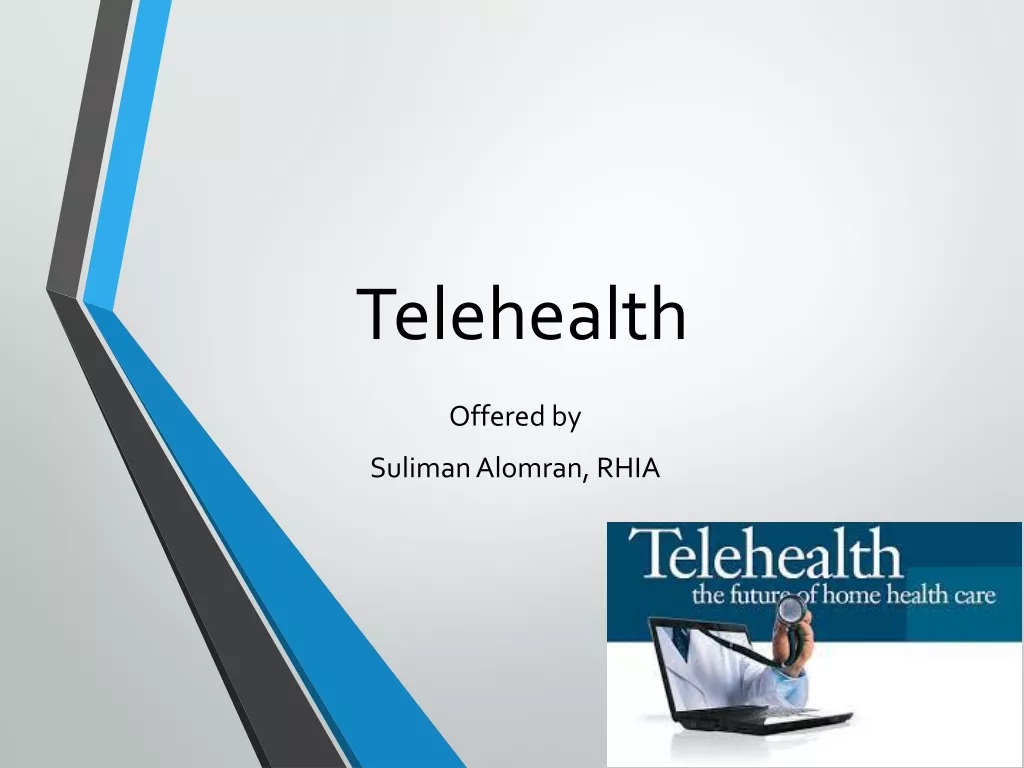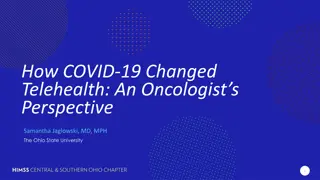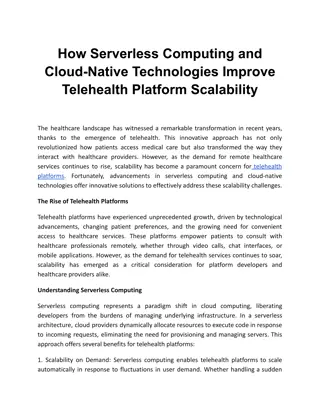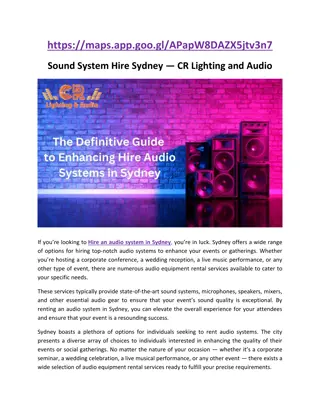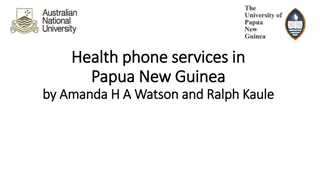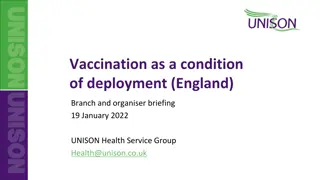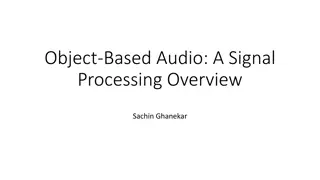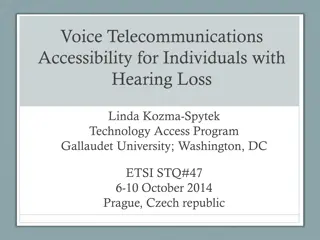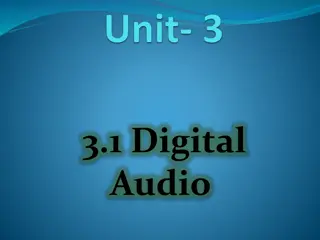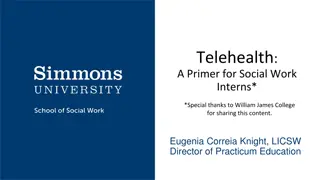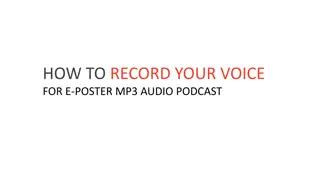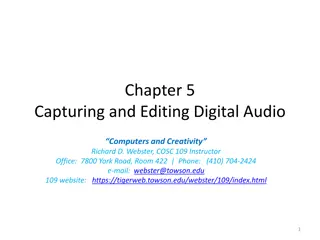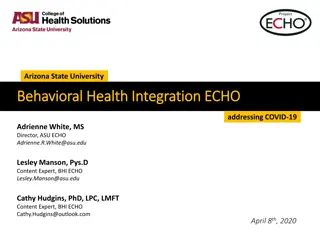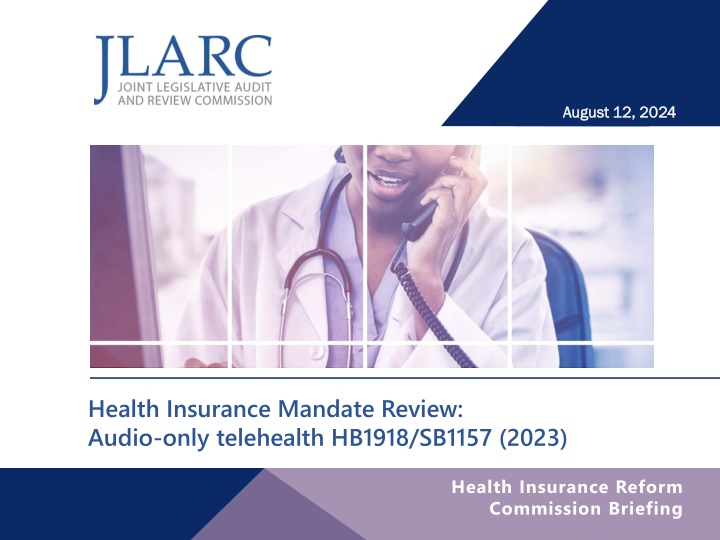
Audio-Only Telehealth Impact on Behavioral Health Services Accessibility
Learn about the potential of audio-only telehealth services in improving access to behavioral health care, addressing mental health challenges and substance abuse disorders. Discover the implications of proposed mandates on coverage and effectiveness of audio-only telehealth services in reducing symptoms of behavioral health conditions amidst professional shortages and limited access to care.
Download Presentation

Please find below an Image/Link to download the presentation.
The content on the website is provided AS IS for your information and personal use only. It may not be sold, licensed, or shared on other websites without obtaining consent from the author. If you encounter any issues during the download, it is possible that the publisher has removed the file from their server.
You are allowed to download the files provided on this website for personal or commercial use, subject to the condition that they are used lawfully. All files are the property of their respective owners.
The content on the website is provided AS IS for your information and personal use only. It may not be sold, licensed, or shared on other websites without obtaining consent from the author.
E N D
Presentation Transcript
August 12, 2024 August 12, 2024 Health Insurance Mandate Review: Audio-only telehealth HB1918/SB1157 (2023) Health Insurance Reform Commission Briefing
Questions for JLARC stage 2 review Is there evidence that the proposed treatment is effective? How commonly used and available is the proposed treatment? How much does treatment cost for individuals without insurance coverage? JLARC 2
In Brief HB 1918/SB 1157 would require coverage of audio-only telehealth services that address mental, emotional, or behavioral disorders if the patient does not have access to real-time video. Audio-only telehealth services can increase access to behavioral health services.* Available research suggests audio-only telehealth services reduce symptoms of behavioral health conditions, but medical experts differ on audio-only telehealth services value and effectiveness vs. in-person or video visits. Audio-only telehealth services account for a very small portion of behavioral health services. * Behavioral health services include mental health and substance abuse services JLARC 3
In this presentation Background Medical efficacy and use of audio-only telehealth Financial impact on individuals without coverage Coverage provided by HB 1918/SB 1157 JLARC JLARC 4
1 in 5 adults experience mental illness, and some face challenges accessing care About 22% of adults in Virginia and 23% of adults nationally reported experiencing mental illness in the prior year Approximately 17% of adults in Virginia and nationally reported a substance use disorder in the prior year Approximately 93 of Virginia s 133 localities are federally designated Mental Health Professional Shortage Areas* 37% of Virginians (3.2 million people) live in these shortage areas Note: Mental Health Professional Shortage Areas have a population to provider ratio that is 30,000 to 1 or greater, or 20,000 to 1 if there are unusually high needs in the community. Sources: SAMHSA, Center for Behavioral Health Statistics and Quality, National Survey on Drug Use and Health, 2021. Virginia Health Care Foundation, Assessment of the Capacity of Virginia s Licensed Behavioral Health Workforce, 2022. JLARC 5
Audio-only telehealth can increase access to behavioral health services Telehealth (audio-only and video) can increase access to care in areas with behavioral health professional shortages, as well as for individuals with limited mobility or transportation challenges In Virginia localities with a shortage of behavioral health professionals, approximately one in five households do not have broadband internet access Audio-only telehealth can improve access to care for these households and for those that lack devices with video capability (e.g., computers, tablets, and smartphones) Source: Virginia Health Care Foundation, Assessment of the Capacity of Virginia s Licensed Behavioral Health Workforce, 2022. JLARC 6
Restrictions on audio-only telehealth services were relaxed during the COVID-19 pandemic Prior to the pandemic, most state Medicaid programs did not allow any use of audio-only telehealth for behavioral health, including Virginia Allowable uses of video telehealth were also limited During the pandemic, federal and state authorities temporarily waived restrictions on telehealth, including audio- only, to allow for continued access to care CMS allowed audio-only telehealth to be used for behavioral health counseling services for Medicare clients All state Medicaid programs and many private insurers also allowed greater use of audio-only telehealth for behavioral health services JLARC 7
HB 1918/SB 1157 applies only to audio-only telehealth services for mental and behavioral health services Definition of audio-only telehealth in HB 1918/SB 1157 specifically refers to counseling interventions designed to remediate mental, emotional, or behavioral disorders and associated distresses These services must be delivered by a licensed mental health professional, as defined in the Code JLARC 8
At least 4 other states require some coverage of audio-only telehealth services Arizona Arizona: Requires coverage if telehealth advisory committee recommends the services may be appropriately provided through audio-only. Recommendations currently align with CMS guidance. New Hampshire New Hampshire: Requires coverage for all modes of telehealth (including audio-only) on the same basis as services provided in person. Vermont Vermont: Requires coverage for all medically necessary, clinically appropriate healthcare services delivered by audio-only telephone to the same extent as in-person services. Washington Washington: Requires coverage of audio-only services if certain conditions are met, including if the service is covered when provided in person, medically necessary, and if the covered person has an established relationship with the provider. JLARC 9
In this presentation Background Medical efficacy and use of audio-only telehealth Financial impact on individuals without coverage Coverage provided by HB 1918/SB 1157 JLARC JLARC 10
Available research shows audio-only services can reduce symptoms for several common behavioral health conditions High-quality, randomized trials on the effectiveness of audio-only services are limited, but available studies have found some evidence that audio-only services can reduce symptoms related to depression, anxiety, PTSD, eating disorders, OCD, and substance use disorder, and be highly effective for supporting medication adherence for patients with severe mental illness Comparison groups vary across studies (e.g., no treatment, treatment as usual, in-person care) JLARC 11
Audio-only telehealth services may promote greater patient retention than in-person care Several studies have found that patients who receive behavioral health services by phone have lower attrition rates For example, a meta-analysis found that average attrition rates across 12 trials of telephone-administered psychotherapy were lower than rates for in-person care Lower attrition rates are likely attributable to reduced barriers (e.g., transportation), greater convenience and perception of value by patients JLARC 12
Several studies have found high levels of patient satisfaction with audio-only telehealth services Several studies have found that patients reported high levels of acceptance and satisfaction with audio-only telehealth services for behavioral health One study of diverse patients found that the satisfaction rate for audio-only services was about the same as video visits Two studies found similar levels of satisfaction between audio-only treatment and the same in-person treatment JLARC 13
Additional research is necessary to determine comparative and long-term effectiveness of audio-only behavioral health services Several meta-analyses found comparable reductions in symptoms between phone, video, and face-to-face treatment for some common behavioral health conditions, but few randomized, controlled studies have directly compared the effectiveness of audio- only services against other treatment modes Mixed evidence is available on the long-term, sustained effects of audio-only services for symptom reduction JLARC 14
Experts opinions vary on value and effectiveness of audio-only behavioral health services Some medical experts interviewed said audio-only services are an effective treatment option for some patients These experts also reported that audio-only services are valuable for increasing care access for rural and low-income individuals & maintaining care for transient populations (e.g., college students) Other medical experts interviewed believe audio-only services are less effective than video or face-to-face, and therefore, do not offer audio-only visits Literature indicates behavioral health experts nationally have diverse attitudes toward audio-only telehealth services JLARC 15
Experts agree audio-only services should only be used when other methods are unavailable Medical experts interviewed generally agree that audio- only services prohibit practitioners from observing visual cues from patients, which are an important source of behavioral health information Experts interviewed indicated that audio-only should not be primary delivery method of services and offered only if in-person or video services are not available; and patients should have ultimate authority to choose their method of receiving services, including the ability to decline use of audio-only services if offered by provider. JLARC 16
Audio-only behavioral health services are likely generally available from providers in Virginia Definitive data on the availability of audio-only behavioral health services is not available, but some sources suggest many providers offer audio-only services A 2023 survey with responses from approximately 10,600 active licensed health care providers across specialties in Virginia found that 69 percent of providers currently use telehealth Of these providers, about 90 percent reported using audio- only services in 2023 About 47 percent of the total responding providers were mental or behavioral health providers The Benchmarking Telehealth Usage in Virginia Survey was conducted by the Virginia Telehealth Network, with support from the Virginia Department of Health and Virginia Department of Health Professions, to inform the State Telehealth Plan. JLARC 17
Audio-only services likely make up a very small percentage of all behavioral health services Among Virginia Medicaid clients, audio-only services were less than 0.1 percent of all behavioral health claims between January 2022 and December 2023* One major health system in Virginia reported that audio- only services were about 2 percent (856 visits) of all behavioral health visits (40,687) between November 2022 and October 2023 Another licensed provider group estimated that audio- only services accounted for between 2 and 5% of their total behavioral health services in 2023 *DMAS staff reported this may be an undercount of total audio-only behavioral services because providers are not yet required to distinguish between audio-only and video services on claims, although many providers voluntarily provide this information. Data on audio-only claims was not recorded prior to 2022. JLARC 18
In this presentation Background Medical efficacy and use of audio-only telehealth Financial impact on individuals without coverage Coverage provided by HB 1918/SB 1157 JLARC JLARC 19
Patient costs of audio-only behavioral health services vary, but are similar to in-person services Providers estimate that patient costs for audio-only behavioral health services can range from $142 to $341 per session per session, depending on service type and duration $142 to $341 Providers set their own rates, and rates may vary depending on the type of counseling or provider For example, a psychiatrist s services may cost more per session than those of a licensed professional counselor, and the frequency of sessions may vary as well. Providers reported that they typically charge the same rates for audio-only services as they do for video or in- person behavioral health services JLARC 20
In this presentation Background Medical efficacy and use of audio-only telehealth Financial impact on individuals without coverage Coverage provided by HB 1918/SB 1157 JLARC JLARC 21
HB 1918/SB 1157 would expand Virginias current telemedicine mandate 38.2-3418.16 of the Code of Virginia currently requires insurance plans to cover the cost of health care services provided through telemedicine services However, definition of telemedicine services explicitly excludes services provided through real-time audio-only telephone HB 1918/SB 1157 would amend this Code section to also require coverage of audio-only telehealth services for behavioral health services when no other means of telemedicine (including video) are available JLARC 22
Medicare and Medicaid cover audio-only behavioral health services Federal Consolidated Appropriations Act of 2023 permanently allows audio-only behavioral health services to be used for Medicare beneficiaries In 2022, Virginia s Medicaid program made permanent changes to cover some audio-only behavioral health services Includes all services covered by Medicare, as well as some additional services Virginia s state employee health insurance plans do not offer coverage for audio-only behavioral health services JLARC 23
HB 1918/SB 1157 would apply to insurance plans covering approximately 1/4 of Virginians JLARC 24
JLARC staff for this report Kimberly Sarte, Associate Director Dillon Wild, Senior Legislative Analyst Laura White, Senior Associate Legislative Analyst JLARC JLARC http://jlarc.virginia.gov/ http://jlarc.virginia.gov/ (804) 786 (804) 786- -1258 25 1258
Appendix: Literature reviewed Castro, A., Gili, M., Ricci-Cabello, I., Roca, M., Gilbody, S., Perez-Ara, M. ., Segu , A., & McMillan, D. (2020). Effectiveness and adherence of telephone-administered psychotherapy for depression: A systematic review and meta- analysis. Journal of affective disorders, 260, 514 526. https://doi.org/10.1016/j.jad.2019.09.023 Chen, P. V., Helm, A., Caloudas, S. G., Ecker, A., Day, G., Hogan, J., & Lindsay, J. (2022). Evidence of Phone vs Video- Conferencing for Mental Health Treatments: A Review of the Literature. Current psychiatry reports, 24(10), 529 539. https://doi.org/10.1007/s11920-022-01359-8 Day, S. X., & Schneider, P. L. (2002). Psychotherapy using distance technology: A comparison of face-to-face, video, and audio treatment. Journal of Counseling Psychology, 49(4), 499 503. https://doi.org/10.1037/0022- 0167.49.4.499 McClellan, M. J., Osbaldiston, R., Wu, R., Yeager, R., Monroe, A. D., McQueen, T., & Dunlap, M. H. (2022). The effectiveness of telepsychology with veterans: A meta-analysis of services delivered by videoconference and phone. Psychological services, 19(2), 294 304. https://doi.org/10.1037/ser0000522 Mohr, D. C., Ho, J., Duffecy, J., Reifler, D., Sokol, L., Burns, M. N., Jin, L., & Siddique, J. (2012). Effect of telephone- administered vs face-to-face cognitive behavioral therapy on adherence to therapy and depression outcomes among primary care patients: a randomized trial. JAMA, 307(21), 2278 2285. https://doi.org/10.1001/jama.2012.5588 Mohr, D. C., Vella, L., Hart, S., Heckman, T., & Simon, G. (2008). The Effect of Telephone-Administered Psychotherapy on Symptoms of Depression and Attrition: A Meta-Analysis. Clinical psychology : a publication of the Division of Clinical Psychology of the American Psychological Association, 15(3), 243 253. https://doi.org/10.1111/j.1468- 2850.2008.00134.x JLARC 26
Appendix: Literature reviewed, contd. Schaffer, C. T., Nakrani, P., & Pirraglia, P. A. (2020). Telemental Health Care: A Review of Efficacy and Interventions. Telehealth and Medicine Today, 5(4). https://doi.org/10.30953/tmt.v5.218 Schlief, M., Saunders, K. R. K., Appleton, R., Barnett, P., Vera San Juan, N., Foye, U., Olive, R. R., Machin, K., Shah, P., Chipp, B., Lyons, N., Tamworth, C., Persaud, K., Badhan, M., Black, C. A., Sin, J., Riches, S., Graham, T., Greening, J., Pirani, F., Johnson, S. (2022). Synthesis of the Evidence on What Works for Whom in Telemental Health: Rapid Realist Review. Interactive journal of medical research, 11(2), e38239. https://doi.org/10.2196/38239 Schulze, L. N., Stentzel, U., Leipert, J., Schulte, J., Langosch, J., Freyberger, H. J., Hoffmann, W., Grabe, H. J., & van den Berg, N. (2019). Improving Medication Adherence With Telemedicine for Adults With Severe Mental Illness. Psychiatric services (Washington, D.C.), 70(3), 225 228. https://doi.org/10.1176/appi.ps.201800286 Slone, N. C., Reese, R. J., & McClellan, M. J. (2012). Telepsychology outcome research with children and adolescents: a review of the literature. Psychological services, 9(3), 272 292. https://doi.org/10.1037/a0027607 Sugarman, D. E., & Busch, A. B. (2023). Telemental health for clinical assessment and treatment. BMJ (Clinical research ed.), 380, e072398. https://doi.org/10.1136/bmj-2022-072398 Turgoose, D., Ashwick, R., & Murphy, D. (2018). Systematic review of lessons learned from delivering tele-therapy to veterans with post-traumatic stress disorder. Journal of telemedicine and telecare, 24(9), 575 585. https://doi.org/10.1177/1357633X17730443 Varker, T., Brand, R. M., Ward, J., Terhaag, S., & Phelps, A. (2019). Efficacy of synchronous telepsychology interventions for people with anxiety, depression, posttraumatic stress disorder, and adjustment disorder: A rapid evidence assessment. Psychological services, 16(4), 621 635. https://doi.org/10.1037/ser0000239 JLARC 27
Appendix: Medical experts interviewed VCU Health UVA Medical Center UVA Center for Telehealth Virginia Academy of Clinical Psychologists JLARC 28

